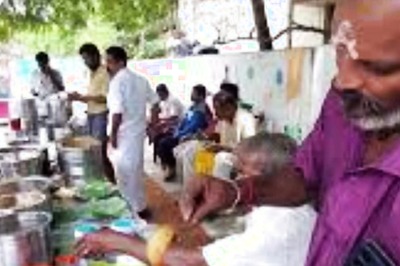
views
As the world stands on the verge of overcoming the Covid-19 pandemic, a fresh concern has arisen, originating from the same place as the initial outbreak—China.
China, once again the protagonist of a respiratory infection, is now under the radar of the World Health Organization (WHO), just like four years ago when Covid-19 was declared in December 2019.
While WHO has urged for additional details regarding the infectious surge, Asia, the US, France, Denmark and the Netherlands have witnessed a rise in hospital admissions among both children and adults. The surge is evident among younger children between the ages of three and eight. However, the latest news reports also show an impact on children aged up to 14 years.
Cases on surge outside China
Recently, Ohio in the US reported nearly 150 cases of pneumonia, all affecting children, with an average age of around eight years old. This surge is similar to the situation in China, sparking global concern.
Ohio’s Warren County Health Department told Daily Mail that the number of cases is above average and meets the Ohio Department of Health’s definition of an outbreak. The Center for Disease Control and Prevention (CDC) said that nationally, cases are not out of the ordinary. Still, the spread of cases has raised fears that an outbreak can overwhelm American hospitals.
Massachusetts also said that it’s being hit by a wave of ‘white lung’ pneumonia in children after Europe reported a surge in cases and hospitalisations.
The Netherlands and Denmark have also reported spikes in “walking pneumonia” cases, mostly among younger children.
The Amsterdam state agency also said during the week of November 13-19, 103 of every 100,000 children between 5 and 14 years old were sick. It is a nearly 25 per cent increase from the previous week when 83 cases were reported for every 100,000 members of the age group.
The spike in these countries follows a similar scenario in Beijing, China, where 7,000 children were admitted to a hospital.
In India, the health ministry has advised all states and Union Territories to immediately review public health and hospital preparedness measures.
What is known so far?
Officials in Ohio have told media that an investigation is “ongoing” and the illness does not look like a new disease but rather several common infections hitting all at once.
It said that so far, patients have tested positive for mycoplasma pneumonia, a bacterial lung infection that is mostly resistant to some antimicrobials, streptococcus and a normally benign infection.
This respiratory illness has been termed as “White Lung Syndrome”. It is primarily affecting children aged three to eight and this illness is not always responsive to antibiotics.
The outbreak is linked to a newly identified strain of mycoplasma pneumonia — a common bacterium responsible for respiratory infections. The syndrome is characterised by distinctive white patches on chest X-rays showing “diffusely damaged lungs”.
Furthermore, the illness appears to be a blend of various ailments, encompassing influenza, SARS-CoV-2, respiratory syncytial virus (RSV), and mycoplasma pneumonia, as per the Chinese government. It could also be a cocktail of different illnesses.
Possible theories to solve the mystery
According to the most reassuring hypothesis, bacterial respiratory infections typically flare up every few years, often coinciding with a surge in influenza or other viral illnesses as people are in the process of recovering.
The other theory is about paying “immunity debt”. It means that due to the reduction of common infections during the Covid-19 lockdowns of 2020 and 2021, we are now catching more infections due to weakened immunity.
Experts believe that with no stringent Covid-19 measures in place, this marks the first winter, likely resulting in heightened exposure and vulnerability to common respiratory infections.
According to Dr John Campbell, a retired Nurse Teacher and A and E nurse based in England, vitamin A deficiency could play a big role in controlling the Chinese outbreak.
Campbell in his popular YouTube video said children in Western countries are often diagnosed with Vitamin A deficiency. He went on to show the WHO guidance on the importance of Vitamin A which proves that this vitamin is needed for mucous membrane innate immunity. It strengthens the respiratory and gastrointestinal tract systems and could be used in prevention.
Also, he pointed out the problem of drug resistance in controlling the spread.
“We have seen that antibiotic resistance is a big problem with mycoplasma pneumonia in China. I am just hoping antibiotic resistance is not spreading around the world… The concerning thing is it is impacting children…”
Also, it’s crucial to consider the hypothesis which proposes a possibility that future pandemics may not necessarily be triggered by viruses but could stem from other perilous pathogens. Examples include methicillin-resistant Staphylococcus aureus or bacteria associated with compromised water and food sanitation.
There is an anticipation that bacteria with multi-drug resistance, along with newly mutated strains, could pose infections to both humans and animals. Researchers underscore that these infections would prove more challenging to treat than those caused by non-resistant bacteria. Ultimately, antibiotic resistance is poised to lead to elevated mortality rates, increased medical expenses, and a strain on logistics, infrastructure, and hospitalisation, as highlighted in a 2022 editorial in the International Journal of Health Sciences.
In the present scenario, antibiotic resistance is already becoming evident. With fingers crossed and the fervent wish that the outbreak fizzles out soon, the critical approach is to enhance preparedness levels and closely monitor the situation.



















Comments
0 comment